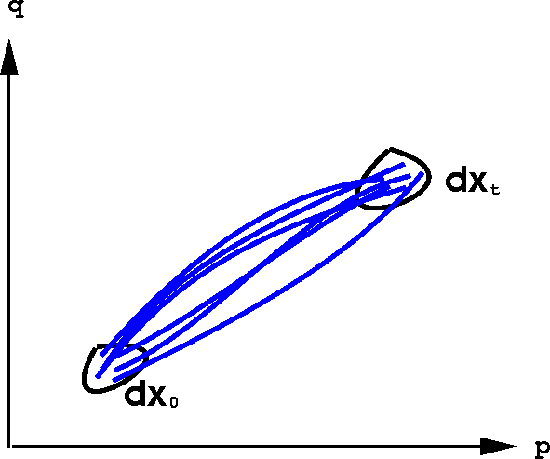4.4: Preservation of Phase Space Volume and Liouville's Theorem
- Page ID
- 5104
Consider a phase space volume element \(dx_0\) at t=0, containing a small collection of initial conditions on a set of trajectories. The trajectories evolve in time according to Hamilton's equations of motion, and at a time t later will be located in a new volume element \(dx_t\) as shown in the figure below:

How is \(dx_0\) related to \(dx_t\)dxdd ? To answer this, consider a trajectory starting from a phase space vector \(x_0\) in \(dx_0\) and having a phase space vector \(x_t\) at time \(t\) in \(dx_t\). Since the solution of Hamilton's equations depends on the choice of initial conditions, \(x_t\) depends on \(x_0\) :
\[ \begin{align*} x_0 &= \left ( p_1 (0), \cdots , p_N(0), r_1(0), \cdots , r_N (0) \right ) \\[4pt] x_0 &= \left ( p_1 (t), \cdots , p_N(t), r_1(t), \cdots , r_N (t) \right ) \\[4pt] x^i_t &= x^i_t \left ( x^1_0 , \cdots , x^{6N}_0 \right ) \end{align*} \]
Thus, the phase space vector components can be viewed as a coordinate transformation on the phase space from \(t=0\) to time \(t\). The phase space volume element then transforms according to
\[ dx_t = J (x_t ; x_0 ) dx_0 \nonumber \]
where \(J (x_t ; x_0 )\) is the Jacobian of the transformation:
\[ J (x_t ; x_0 ) = \frac {\partial (x^1_t \cdots x^n_t )}{\partial (x^1_0 \cdots x^n_0 )} \nonumber \]
where \(n=6N\). The precise form of the Jacobian can be determined as will be demonstrated below.
The Jacobian is the determinant of a matrix \(M\),
\[ J (x_t ; x_0 ) = \text {det} (M) = e^{TrlnM} \nonumber \]
whose matrix elements are
\[ M_{ij} = \frac {\partial x^i_t}{\partial x^j_0} \nonumber \]
Taking the time derivative of the Jacobian, we therefore have
\[ \frac {dJ}{dt} = Tr \left ( M^{-1} \frac {dM}{dt} \right ) e^{TrlnM} \nonumber \]
\[ = J \sum _{i=1}^n \sum _{j=1}^n M^{-1}_{ij} \frac {dM_{ij}}{dt} \nonumber \]
The matrices \(M_{-1} \) and \( \frac {dM}{dt} \) can be seen to be given by
\[ M^{-1}_{ij} = \frac {\partial x^i_0}{\partial x^j_t} \nonumber \]
\[\frac {dM_{ji}}{dt} = \frac {\partial \dot {x}^i_t}{\partial x^i_0} \nonumber \]
Substituting into the expression for \(dJ/dt\) gives
\[\begin{align*} \frac {dJ}{dt} &= J \sum _{i,j=1}^n \frac {\partial x^i_0}{\partial x^j_t} \frac {\partial \dot {x}^i_t}{\partial x^i_0} \\[4pt] &= J \sum _{i,j,k=1}^n \frac {\partial x^i_0}{\partial x^j_t} \frac {\partial \dot {x}^i_t}{\partial x^k_t} \frac {\partial x^k_t}{\partial x^i_0} \end{align*} \]
where the chain rule has been introduced for the derivative \(\frac {\partial x^j_t}{\partial x^i_0}\). The sum over i can now be performed:
\[\sum _{i=1}^n \frac {\partial x^i_0}{\partial x^j_t} \frac {\partial x^k_t}{\partial x^i_0} = \sum ^n_{i=1} M^{-1}_{ij} M_{ki} = \sum ^n_{i=1} M_{ki}M^{-1}_{ij} = \delta _{kj} \nonumber \]
Thus,
\[\frac {dJ}{dt} = J \sum ^n_{j,k=1} \delta _{jk} \frac {\partial \dot {x}^j_t}{\partial x^k_0} \nonumber \]
\[ J \sum ^n_{j=1} \frac {\partial \dot {x}^j_t}{\partial x^j_t} = J \nabla _x \cdot \dot {x} \nonumber \]
or
\[ \frac {dJ}{dt} = J \nabla _x \cdot \dot {x} \nonumber \]
The initial condition on this differential equation is \(J (0) \equiv J (x_0; x_0) = 1 \). Moreover, for a Hamiltonian system \(\nabla _x \cdot \dot {x} = 0 \). This says that \(dJ/dt=0\) and \(J(0)=1\). Thus, \(J (x_t ; x_0 ) = 1 \). If this is true, then the phase space volume element transforms according to
\[ dx_o = dx_t \nonumber \]
which is another conservation law. This conservation law states that the phase space volume occupied by a collection of systems evolving according to Hamilton's equations of motion will be preserved in time. This is one statement of Liouville's theorem.
Combining this with the fact that \(df/dt=0\), we have a conservation law for the phase space probability:
\[ f(x_o, o) dx_o = f(x_t,t)dx_t \nonumber \]
which is an equivalent statement of Liouville's theorem.


